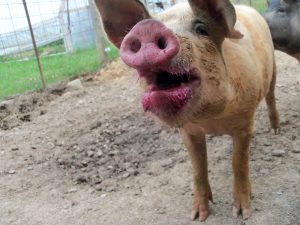Between the Covid-related lockdowns, my nephew’s weeklong visit, and the two-week stay by a farm volunteer from Maine, the gardens look better and are more productive than any in recent years. So, let’s go on a tour of the farm gardens so I can show you what is growing.

Who says you can’t put lipstick on a pig: she just polished off some beets.
The entire garden area lies beyond the north side of the inner barn corral and the east side of the outer corral. The plantings are split between the 25-by-50-foot hoop house and two large plots to its south and north.
The hoop house is laid out to accommodate six rows of produce, with each row watered by drip tape. Growing currently are tomatoes, tomatillos, celery, peppers, cucumbers, cabbage, winter squash, kale, and some remarkably resilient Swiss chard. The chard was planted last August and has already been cut to the ground four times. The plants’ bases have grown to more than four inches in diameter, and they quickly send up fresh shoots after cutting. In a very unscientific experiment, I plan to let them keep regenerating for as long as they would like.
The tomatoes just started ripening in the past two weeks. Already, they manage to make an appearance on the breakfast, lunch, and dinner menus, but my favorite way to eat a tomato will always be the most basic: a thick slab sprinkled with coarse salt and fresh-ground pepper, preferably eaten under a large shade tree.
The potatoes (red Norland and white Kennebec) and the turnips have all been harvested from the bed just north of the hoop house. The former, planted this year in a new location, managed to elude the worst of the pests and yielded a couple of hundred pounds. The turnips always grow well, and they will be replanted under cover later next month for a winter crop to see us into next spring. Meanwhile, they have been replaced with two varieties of winter squash.
Also in the north garden is a row of kale and chard. Our farm volunteer, Ali, just finished trimming the chard to its core and cutting the kale back to the main stalk to encourage fresh growth on both. Each should produce well into the winter. One row over is the okra, a Louisiana heirloom called Dub Jenkins, with thick round pods — which, when rolled in corn meal batter and fried alongside catfish this weekend, was declared delectable by all. Tennessee melons are planted in a double row next to the okra, and they should be ready to begin harvesting later this week. A large mound of prolific and tasty yellow crookneck squash rounds out the north bed.
In the south garden, closest to the inner corral, is the bean patch. It consists of four 50-foot rows, one of Murphy pole beans, two of Polecat field peas, and one of Snow on the Mountain butter beans. This past week we harvested more than 30 pounds of the Murphy pods, then strung, snapped, and froze them. The butter beans will be ready to harvest in another week; field peas will begin in August and continue heavy well into September.
Across the eastern fence from these three gardens live six fast-growing gilts, happy beneficiaries of all excess produce. Over two decades of farming, we have learned the importance of raising at least one garden pig each year. There are always hogs in the woods, but having one or more near the garden makes for a thrifty and nutritional way to supplement their feed. As soon as they hear that garden gate open, they crowd the fence, grunting and snorting and shoving, waiting to be favored with overripe tomatoes or tough outer cabbage leaves.
Well, that is the tour done and dusted. Give me a second to turn on the water in the melon patch and close the gate, and then we can head back to the house. I hope you’ve enjoyed walking with me today.
